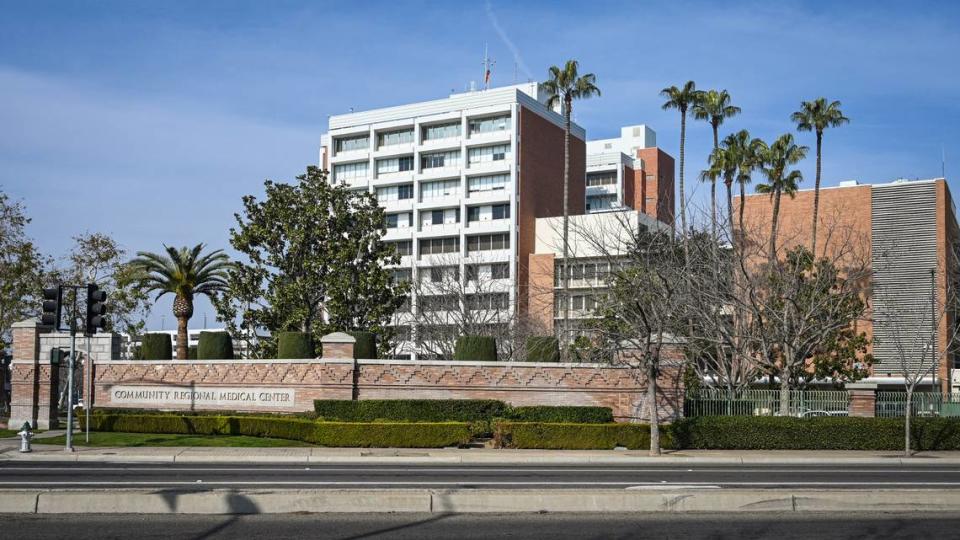‘Unfair.’ ‘Inequitable.’ Fresno leader wants transit between downtown, Clovis hospitals

As Fresno city leaders debate a $1.85 billion budget for the upcoming fiscal year, one councilmember is proposing a new transit line to connect two of the region’s hospitals.
During budget hearings Tuesday, Councilmember Miguel Arias, who represents District 3 — which includes downtown Fresno’s Community Regional Medical Center hospital — made a motion to allocate $500,000 to fund a route for a transit line between the downtown hospital and Clovis Community Medical Center.
Arias estimates the 12-mile trek between CRMC downtown and Clovis Community is an hours-long bus ride with multiple connections “and then a half-mile walk to the actual hospital.”
In an interview with The Bee, Arias said “it is unfair, and inequitable, and a danger to the public health of our residents to simply allow a Clovis hospital 15 minutes away to have dozens of empty beds, while the one at the core of our city has patients packed in hallways and outside tents.”
As of June 6, Community Regional is at 122% of capacity compared to Clovis Community at 108%, Thomas Utecht, system chief medical officer for Community Medical System, which operates both hospitals, said in an email statement to The Bee. About 50% of inpatients at Clovis Community live in Fresno, he said.
While the average emergency department wait time at both hospitals is 28 minutes, the average time a patient spends in the emergency department, from arrival to discharge, is about 4.57 hours at the downtown facility — about 41 minutes longer than at the Clovis facility, Utecht said.
Still, Arias said that sending patients to Clovis Community could help relieve the pressure at CRMC downtown.
“I’ve been told by Community Medical Centers they’re one system,” he said, “and there’s just no connectivity to the other place where all the available beds are.”
Community Health System leadership said they didn’t know enough about the transportation discussions to weigh in at this point.
Utecht said, however, that if someone is in “serious healthcare distress,” they “shouldn’t rely on public transportation for emergency care, but should call an ambulance.”
Another Fresno-area hospital pays for a similar FAX line
This wouldn’t be the first publicly administered transit program for local private hospitals.
Interim transportation director Gregory Barfield said the proposal would be “a similar model” to Fresno Area Express line 58E, which runs on an hourly basis between Fresno’s River Park area and Valley Children’s Hospital, which sits north of Fresno in Madera County. The FAX route is paid for by Valley Children’s Hospital as part of a mitigation settlement when the hospital moved from central Fresno to Madera in 1998, Barfield said.
He agreed with Arias that the patients’ transportation issues are “frustrating.”
“We just deal with bad,” he said with a pause, “with sprawl.”
In an interview with The Bee, Arias said the proposed route is about ensuring the region’s most vulnerable, most sick and unhoused residents have access to urgent medical care.
“We’ve seen the largest flagship healthcare system in our county be an obstacle for people in Fresno getting health care access,” he said.
A 2022 Fresno Bee investigation found that over the past decade, Community Health System (formerly the Community Medical Centers) has used state and federal money intended to offset the cost of providing care for indigent patients, primarily in downtown Fresno, to help fund a $1 billion hospital expansion in affluent Clovis.
“In an ideal situation,” Arias said, Community Medical should cover costs of transportation between the two hospitals. “But for now, I think it’s on us to fill the gap.”
Extending free Fresno bus fare?
City councilmembers on Tuesday also examined ways to fund free bus fare for qualifying Fresnans.
The city currently offers anyone under 12, veterans, and military personnel recipients free fare in perpetuity, Barfield said.
A $500,000 grant from Kaiser Permanente helps fund free rides for seniors 62 years and older, Medicare-card holders, and people with disabilities.
Annual FAX ridership is estimated at 8 million rides per year, Barfield said, which is “close” to pre-pandemic numbers. To date, Bardfield said the Kaiser funds have paid for nearly 706,000 rides at 50 cents a piece — but the funds are expected to run out “sometime in August.”
“We’re working very diligently to give Kaiser that nudge forward,” he said.
Should external funding for the service fall through, however, Barfield said there are other nonprofit corporations that “could step forward.”
Council President Tyler Maxwell, who represents central and east Fresno in District 4, made a motion to request $500,000 to continue those services — contingent upon the city not receiving external grant funding.
“I can’t in good faith bank on other folks’ generosity and philanthropy to help those populations,” he said. In the past, Maxwell said he supported a zero fare city transit system.
Maxwell also made a motion to add nine bus stops in his district to a list of 75 stops citywide that need shade shelters.
Budget resolutions will be voted on next week.
